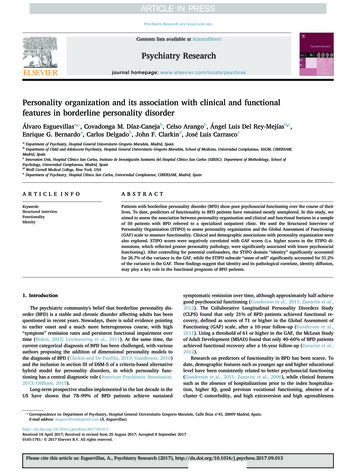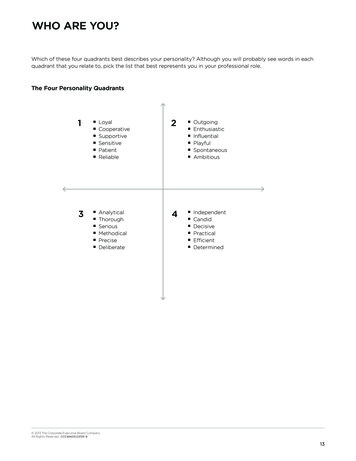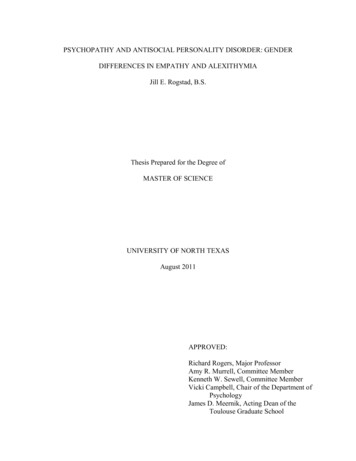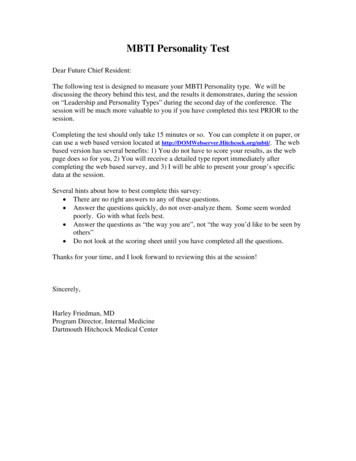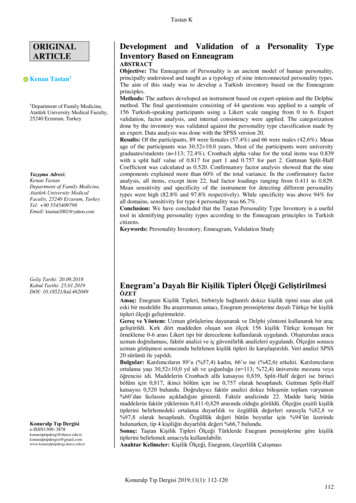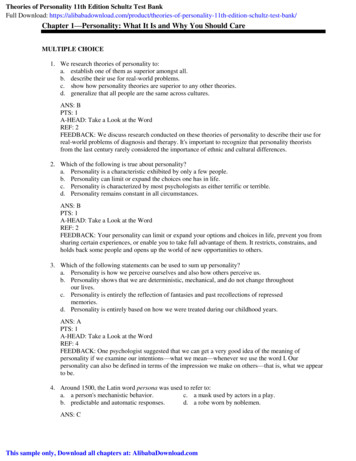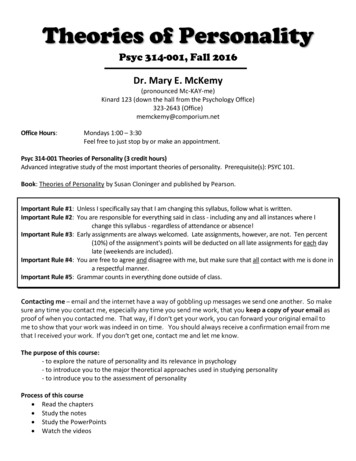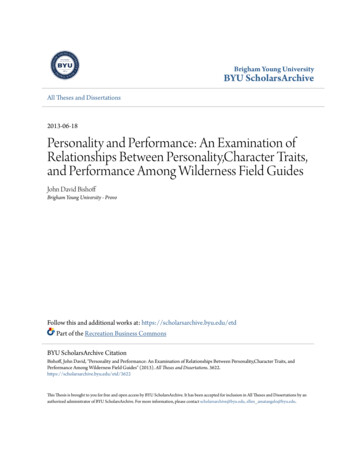
Transcription
Brigham Young UniversityBYU ScholarsArchiveAll Theses and Dissertations2013-06-18Personality and Performance: An Examination ofRelationships Between Personality,Character Traits,and Performance Among Wilderness Field GuidesJohn David BishoffBrigham Young University - ProvoFollow this and additional works at: https://scholarsarchive.byu.edu/etdPart of the Recreation Business CommonsBYU ScholarsArchive CitationBishoff, John David, "Personality and Performance: An Examination of Relationships Between Personality,Character Traits, andPerformance Among Wilderness Field Guides" (2013). All Theses and Dissertations. 3622.https://scholarsarchive.byu.edu/etd/3622This Thesis is brought to you for free and open access by BYU ScholarsArchive. It has been accepted for inclusion in All Theses and Dissertations by anauthorized administrator of BYU ScholarsArchive. For more information, please contact scholarsarchive@byu.edu, ellen amatangelo@byu.edu.
Personality and Performance: An Examination of Relationships Between Personality,Character Traits, and Performance Among Wilderness Field GuidesJohn D. BishoffA thesis submitted to the faculty ofBrigham Young Universityin partial fulfillment of the requirements for the degree ofMaster of ScienceMark A. Widmer, ChairStacy TaniguchiJohn B. BinghamDepartment of Recreation ManagementBrigham Young UniversityJune 2013Copyright 2013 John D. BishoffAll Rights Reserved
ABSTRACTPersonality and Performance: An Examination of Relationships Between Personality,Character Traits, and Performance Among Wilderness Field GuidesJohn D. BishoffDepartment of Recreation ManagementMaster of ScienceThe purpose of this study was to examine the relationship between job performance ofwilderness and adventure therapy (WAT) field guides and personality traits. Specifically, thisstudy utilized the NEO-PI-R to assess personality and the Field Guide Performance Evaluation(FGPE) to assess job performance. Job performance was measured by managers, peers, andWAT participants. The sample consisted of 89 personality assessments, gathered from both theU.S. and Canada. Ordinary least squares regression analysis indicated there was a nonsignificant relationship between field guide job performance and personality. Findings provideimplications for WAT practitioners seeking the most qualified field guides possible.Keywords: wilderness adventure therapy, job performance, personality, field guide
ACKNOWLEDGEMENTSFirst of all, I would like to thank Dr. Mark Widmer for all the countless hours he hasspent with me working out the details of the study and for all the additional resources he hasprovided to me during my tenure at BYU. I would also like to thank Dr. John Bingham for theearly morning statistics lessons and all the hours he has spent mentoring me. I would also like tothank Dr. Stacy Taniguchi for the time he has spent helping me become a better writer and amore critical thinker.I would also like to thank my dear wife, who has sacrificed much for my education. Sheis my support and the reason I do what I do. I would also like to acknowledge my cohort,specifically, Christian, for all the long hours spent in the cave, Rob, for all the help and longtalks, and Warren, for the unique insight into life.
ivTable of ContentsIntroduction. . 1Literature Review. 6Methods. 12Results . 16Discussion and Conclusion . 19References . 23Appendix A: Field Guide Personality Assessment . 30Appendix B: Field Guide Performance Evaluation-Managers/Peers (FGPE-MP) . 59Appendix C: Field Guide Performance Evaluation-Student (FGPE-S) . 73Appendix D: Prospectus . 84
PERSONALITY AND PERFORMANCE1Personality and Performance: An Examination of Relationships Between Personality,Character Traits, and Performance Among Wilderness Field GuidesWilderness experience programs (WEP) are “organizations that conduct outdoorprograms in wilderness or comparable lands for the purposes of personal growth, therapy,rehabilitation, education, or leadership/organizational development” (Friese, Hendee, &Kinziger, 1998, p. 40). The literature is replete with studies touting the efficacy of wildernessexperience programs (WEPs) to positively influence individuals with a variety of behavioral andemotional problems across their respective life spans (Hood, 2003; Judge, 2005; Russell, 2006;Scholl, McAvoy, Rynders, & Smith, 2003; Useem, 2001). In one specific form of WEP,wilderness adventure therapy (WAT), licensed therapists and field guides work with clients whoengage in activities such as backpacking, rock climbing, canoeing, and skiing (Jones, Lowe, &Risler, 2004). Existing research on WAT organizations has “primarily focused on definitions,industry characteristics, outcome assessments, standardization, and professionalization of theworkforce” (Marchand, Russell, & Cross, 2009, p. 360).An often overlooked but important component of wilderness therapy, however, is therelationship between field guides and clients. Very little is known about the personality andcharacter traits field guides must have in order to facilitate effective change in clients (Taniguchi,Widmer, Duerden, & Draper, 2009). Therefore, the purpose of this study was to evaluateselection procedures used to make hiring choices within WATs and to determine if specificrelationships exist between personality traits and job performance of field guides.Personality, character traits, and fit are an important aspect of employment in mostorganizations, and WAT organizations are no different. Many organizations utilize assessmenttools to help them determine a potential employee’s fit, personality, and character traits for a
PERSONALITY AND PERFORMANCE2specific job description. Most WAT organizations, however, do not utilize these valuableassessments to select the best candidates for their field guides. Given the difficult, yet vital roleof the field guide in WAT, an understanding of personality traits associated with successfullymeeting the demands of this job seems crucial for the long-term vitality of the organization, thefield guide, and the client. If, indeed, certain traits are associated with successful jobperformance, WAT organizations might use personality measures as screening instruments toidentify and recruit the best field guides.An effective way to measure job performance is to obtain 360-degree (360) feedback.This performance measure involves obtaining feedback from subordinates, peers, and bosses. Inthis case, the subordinates are the program participants. Three-sixty degree feedback provides amore complete picture of performance by utilizing evaluations from important stakeholderswithin the organization and offers relevant job information that would otherwise be unavailable(Mount, 1998). Currently, no research examines the relationship between personality andeffectiveness of field guides in WAT utilizing 360 evaluations. The important role field guidesplay in facilitating the therapeutic process of clients necessitates this research which may haveimportant implications for the organization, client, and employee.Two likely benefits are associated with identifying and recruiting the best field guides.First, they are likely to be more effective at building and maintaining therapeutic relationshipswith the clients, thus making the program more effective (Moses, 2000). Second, they are likelyto be happier on the job and stay on the job longer, thus reducing the high cost of recruitment andtraining (Hogan & Holland, 2003; McEvoy & Cascio, 1985; Mobley, 1977). Due to the paucityof research on character traits and employee performance of wilderness field guides, this studymay provide initial insights into character traits associated with being an effective field guide.
PERSONALITY AND PERFORMANCE3Conscientiousness, Agreeableness, and Job PerformancePast literature has consistently shown Conscientiousness is a trait which is positivelycorrelated with job performance and is generalizable across various job types and settings(Barrick & Mount, 1991). Similarly, Agreeableness is positively correlated with jobperformance when team work and collaboration are needed (Mount, Barrick, & Stewart, 1998).Both Conscientiousness and Agreeableness should be highly sought after traits for field guides.Due to the nature of their jobs, field guides generally utilize a fairly complex set of soft and hardskills necessary to successfully complete their work responsibilities. Field guides must bewilling to perform their duties at all times regardless of weather, time of day, or personalpreferences.Performance determined by managers. Because no universal field guide performanceevaluation within WAT exists, we gathered the performance evaluations of each organizationand looked for common themes between the evaluations. After review of each performanceevaluation, analysis revealed the ideal candidate for a field guide position possesses the ability tomanage risk, dependability, and the necessary skills to successfully navigate the outdoors.Management is concerned about the well-being of their clients and wants to be assured their fieldguides prioritize client safety and well-being. Because Conscientiousness and Agreeablenesshave consistently shown to be positively correlated with job performance, the following is ourfirst hypothesis:Hypothesis 1: A significant (p .05) positive correlation will be found between scoreson SDS and scores on Agreeableness and Conscientiousness from NEO-PI-R on ratingsfrom employers.
PERSONALITY AND PERFORMANCE4Performance determined by co-workers. Generally, field guides work in pairs of two.They share the responsibilities of teaching clients to navigate the outdoors, lead trips, andcomplete paperwork associated with their jobs. Analysis of performance reviews (see appendixunder SDS) revealed field guides prefer to have co-workers who are easy to get along with, shareresponsibilities equally, take initiative, are team players, and follow through with their duties andassignments. Co-workers, then, prefer someone who is Conscientious and Agreeable.Therefore, the following is our second hypothesis:Hypothesis 2: A significant (p .05) positive correlation will be found between scores onSDS and scores on Agreeableness and Conscientiousness from NEO-PI-R on peer ratings of coworkers.Performance determined by clients. Field guides are responsible for the well-beingand safety of the client during their work shifts on-trail. Because field guides are informallyresponsible for most of the therapeutic work of WAT clients, a positive relationship betweenfield guides and clients is mandatory for the client’s physical and emotional welfare. Taniguchiet al. (2009) found participants in a wilderness adventure program clearly valued specificpersonality traits among field staff. Clients entering WAT programs may not have had strongmodeling of positive communication and coping skills. Field guides can become an importantand positive role model for clients to learn strong social and coping skills. Research is limited onthe traits clients feel are important for field guides to possess. Our third hypothesis is thefollowing:Hypothesis 3: A significant (p .05) positive correlation will be found between scores onSDS and scores on Agreeableness and Conscientiousness from NEO-PI-R on ratings from WATclients.
PERSONALITY AND PERFORMANCE5Statement of the ProblemThe problem of this study was to explore potential relationships between personalitytraits and employee performance in field guides working in WATs.Purpose of the StudyThe purpose of the study was to determine the relationships between performance scoresand scores of personality and character strengths among field guides in WATs.Significance of the StudyCompanies offering wilderness therapy are confronted with a deluge of challenges fromhigh employee turnover and burnout due to the emotional and physical challenges inherent totheir job descriptions to working with unruly and troubled adolescents (Marchand, 2008). Highturnover rates and burnout of field guides result in a substantial drain on financial and humanresources associated with recruitment, hiring, and training. Valuable organizational knowledgeand history are lost when employees leave (Ashworth, 2006; Massingham, 2008; Parise, Cross,& Davenport, 2006). Research has not examined the cost of turnover to wilderness therapyprograms; however, estimates in the hospitality industry indicate turnover costs for a front-deskassociate range anywhere from 5,688 to 12,881 (Hinkin & Tracey, 2000). It is likely the costof turnover in wilderness therapy is much higher. The process of hiring new employees not onlystresses the wilderness therapy institution, but the clients as well. Clients are constantly dealingwith rules and expectations of different field guides, which could have a negative effect theefficiency of the program to facilitate therapy. The challenges confronting the individualemployees are not to be overlooked. The work of wilderness field guides can be stressful. Workissues can also cause field guides to struggle in their relationships with family and friends due toschedule constraints, anxiety, and physical and emotional challenges (Marchand, 2008).
PERSONALITY AND PERFORMANCE6The current body of literature has failed to address the importance of personality ofwilderness field guides and its relationship to employee performance. This lack of knowledgenecessitates this study. The need for establishing the importance of certain traits for field guidesis essential for the health and vitality of field guides, the efficiency of the wilderness therapyprogram, and the mental and physical well-being of the client.Literature ReviewThe purpose of this study was to determine the relationships between performance scoresand scores of personality and character strengths among field guides in WATs. This review ofliterature will examine research relating to employee performance and personality traits in amanagement setting as well as the limited research on personality in the wilderness therapysetting. The following topics will be discussed in this chapter: (a) current research onpersonality, (b) employee performance (c) wilderness therapy programs, and (d) the impact ofworking as a field guide for a wilderness therapy program. Finally, an examination of the lack ofresearch on the effects of personality on employee performance in the wilderness therapyindustry will set the stage for further analysis, per Taniguchi et al., (2009).PersonalityAn individual’s underlying personality inevitably influences how they will perform onthe job. Investigations of personality began in the 1930s and have been adopted by the fields ofpsychiatry, psychopathology, sociology, and American psychology (John, Robins, & Pervin,2008). More recently, personality research has been used to determine organizationalcitizenship, contextual performance, and change-oriented extra-role behaviors on workeffectiveness (Chiaburu, Oh, Berry, Li, & Gardner, 2011). Current research in personality tends
PERSONALITY AND PERFORMANCE7to focus on an individualistic approach where personality traits are individually scrutinized toassess choice and satisfaction (Barrick & Mount, 1991; Lee, Johnston, & Dougherty, 2000).Within the last 20 years, personality psychologists have converged regarding structureand concepts of personality, classifying the taxonomy into five robust factors: (a) agreeableness,(b) conscientiousness, (c) openness to experience, (d) neuroticism, and (e) extraversion (Barrick& Mount, 1991).Big five personality traits. Extensive research has examined the effectiveness of the fiveaforementioned traits (Chiaburu et al., 2011; Oh & Berry, 2009; Oh, Wang, & Mount, 2011).This Five-Factor Model (FFM) has become a mainstay in regards to personality research, notingnearly all personality traits can be understood in terms of these five dimensions (Costa, McCrae,& Kay, 1995). Costa and McCrae (1992) developed the NEO Personality Inventory (NEO PI) asa “reasonable representation of human personality” (McCrae & Costa, 1987, p. 81) and ispredictive of job performance, leadership, and other work-related criteria (Ones, Dilchert,Viswesvaran, & Judge, 2007). The comprehensiveness of the FFM, in predicting jobperformance, has allowed it to be used across different theoretical frameworks, in differentcultures and languages, and with a variety of samples.Neuroticism. Neuroticism is defined as an individual’s susceptibility to psychologicaldistress, the tendency to experience anxiety, feelings of guilt, shyness, or depression and has alsobeen referred to as Emotional Stability, Stability, and Emotionality (Barrick & Mount, 1991;Costa & McCrae, 1992). Individuals who rate high in Neuroticism tend to prefer and adaptbetter to positive environments that are less ambiguous and unthreatening (Oh & Berry, 2009;Szalma & Taylor, 2011). Neuroticism can predict “impairment of working memory, attentionalresources, and sustained attention, biases in selective attention for negative information, a
PERSONALITY AND PERFORMANCE8tendency to appraise environmental demands as threats, and greater sensitivity to threatinformation” (Szalma & Taylor, 2011, p. 72). Individuals who score low in this trait tend toshow confidence, self-assurance, and optimism (Oh & Berry, 2009).Agreeableness. Agreeableness can be defined as the ability to work with others. It isassociated with sympathy, altruism, helpfulness, tender mindedness, and a propensity to trustothers (Costa & McCrae, 1992). Individuals who rate high in agreeableness tend to adapt well tointerpersonal settings and have lower levels of distress, which can be based on an individual’sdesire to be prosocial (Chiaburu et al., 2011; Szalma & Taylor, 2011). Agreeableness is acomponent of trust and inspires trust in situations of high uncertainty or risk (Szalma & Taylor,2011). Agreeableness may not always be a desired trait for managers and may not be a validpredictor of leader effectiveness (Judge, Bono, Ilies, & Gerhardt, 2002; Oh & Berry, 2009).Conscientiousness. Conscientiousness reflects dependability, thoroughness,responsibility, and organization (Barrick & Mount, 1991) and is the single-best, generalizableBig Five predictor of job performance (Ones et al., 2007). Lee et al. (2000) showedConscientiousness is composed of two factors: achievement orientation and dependability.Barrick and Mount (1991) showed Conscientiousness was a valid predictor of taskaccomplishment for all occupational groupings (e.g., professionals, police, managers, sales,skilled/semi-skilled workers). Barrick, Stewart, and Piotrowski (2002) found Conscientiousnessis correlated with accomplishment striving and status. Those scoring low on the Conscientiousscale may need help with time management, organizational skills, and motivation (Lee et al.,2000). Conscientiousness is a difficult trait for interviewers to assess in job applicants due to theapplicant’s ability to manage their self-presentation during interviews (Barrick, Patton, &Haugland, 2000).
PERSONALITY AND PERFORMANCE9Openness to Experience. Openness to Experience is the most difficult dimension toidentify and has not been as extensively studied as the other traits (Barrick & Mount, 1991; Pace& Brannick, 2010). Openness to Experience includes imagination, tolerance, appreciation ofarts, and breadth of interests. Openness to Experience may be important when targeting diversityattitudes or to cultural training that uses skills such as cultural empathy, behavioral flexibility,and tolerance (Lee et al., 2000). Pace and Brannick (2010) showed Openness to Experience maybe helpful with jobs requiring employees to adapt to changing demands and to generate novelideas.Extraversion. Extraversion has been defined as “the enjoyment of others’ company”(McCrae & Costa, 1987, p. 87) and can be associated with persuasiveness, leadership,sociability, energy, assertiveness, activity level, and a preference for excitement (Oh & Berry,2009; Szalma & Taylor, 2011). Barrick and Mount (1991) found Extraversion was a validpredictor of training proficiency across all occupations requiring interpersonal skills and led tomore effective performance in jobs that required traits such as sociability, gregariousness,assertiveness, action, and the ability to be talkative. Extraversion is the easiest trait to assessbecause the inherent traits mentioned above enhance the visibility of the trait (Barrick et al.,2000). Extraversion is correlated with high performance only when performance has beenexplicitly rewarded and seems to show a weak relationship between citizenship and extraversion(Barrick et al., 2002; Chiaburu et al., 2011).Personality and PerformanceMeta-analyses repeatedly found relationships between personality and performanceacross all job types and contexts (Barrick & Mount, 1991; Chiaburu et al., 2011; Oh et al., 2011).Current theory and research have converged on the belief employee performance should be
PERSONALITY AND PERFORMANCE10defined by the following dimensions: (a) task performance, (b) organizational citizenshipbehavior (OCB), and (c) counterproductive work behavior (CWB) (Dalal, 2005; Le et al., 2011).According to Motowidlo and Van Scotter (1994), task performance includes two classes ofbehavior. The first consists of activities that transform raw materials into goods and services theorganizations produce (e.g., selling merchandise in a retail store or teaching a client to backpackin a wilderness therapy program). The second consists of maintaining and servicing thetechnical requirements that enable an organization to run smoothly such as planning,coordinating, supervising, and staffing. OCB can be defined as “contributions to themaintenance and enhancement of the social and psychological context that supports taskperformance” (Organ, 1997, p. 91). CWB, on the other hand, is defined as “intentionalemployee behavior that is harmful to the legitimate interests of an organization” (Dalal, 2005, p.1241–1242).Wilderness Therapy ProgramsWilderness therapy programs are a form of therapeutic experiential education. Learningopportunities are created using direct experience. The experiences are intended to facilitatepersonal growth and development. These programs utilize experiential education by immersingclients in a setting where their skills and self-concepts are challenged and developed. Hattie,Marsh, Neill, & Richards, (1997) describe the following features inherent in most adventureprograms:(a) wilderness or backcountry settings; (b) a small group (usually less than 16); (c)assignment of a variety of mentally and/or physically challenging objectives, such asmastering a river rapid or hiking to a specific point; (d) frequent and intense interactions
PERSONALITY AND PERFORMANCE11that usually involve group problem solving and decision making; (e) nonintrusive, trainedleader; and (f) a duration of two to four weeks. (p. 44)The challenges inherent to WAT programs allow for optimal experiences, where clients feel abalance between their personal skill level and the challenge of the activity (Csikszentmihalyi &Csikszentmihalyi, 1990). Generally, adventure programs produce positive growth because theyprovide a sense of accomplishment and efficacy (i.e., natural occurring consequences). Thesechallenges lead to improved satisfaction and promote the development of proper social andadaptive behaviors (Becker, 2010).Field guides. Field guides have the challenge and responsibility of caring for clients inremote, outdoor settings. They teach clients the vital skills necessary to navigate the challengesof the wilderness. These skills range from fire building, outdoor cooking, and packing abackpack, to more advanced skills such as mountain biking and rock climbing. Field guidestypically eat similar food as the clients and use the same minimal outdoor gear as the clients.They live in potentially hostile environmental conditions such as the hot, summer sun to frigid,winter winds and snow. Field guides endure the physical rigor from miles of difficult hiking,backpacking, mountain biking, and other strenuous outdoor activities. Work shifts can be long—often eight days on and six days off. Field guides also endure substantial emotional stressassociated with the challenges of working with troubled adolescents who are away from homeand living in the rugged wilderness environment, often for the first time. Clearly, the role of afield guide presents unique physical and emotional challenges, challenges unlike any other job.Marchand et al. (2009) surveyed field guides and found a 9:1 ratio of negative aspects of being afield guide over the benefits. Due to the difficult work environment, most field guides work 6–18 months before leaving. Yet, they will often report the job is immensely rewarding.
PERSONALITY AND PERFORMANCE12What personality strengths are most advantageous for field guides to possess? How doespersonality influence employee performance in the wilderness therapy setting? How do the FFMtraits of Conscientiousness and Agreeableness affect a field guide’s performance? Doesperformance affect the term of employment for a field guide? These questions have yet to beanswered. Therefore, the purpose of this study is to examine the relationships betweenperformance scores and scores of personality and character strengths among field guides inWATs.MethodsThe purpose of this study is to examine the relationships between performance scores andscores of personality and character strengths among field guides in WATs within the U.S. andCanada. This chapter outlines the structure and methods of the study. The following areas willbe covered: (a) study sample, (b) instrumentation, (c) data collection procedures, (d) dataanalysis.Study SampleA convenience sample of 89 field guides within the United States and Canada contributedpersonality data for this study. Additionally, 54 managers, 71 peers/co-workers, and 95 WATparticipants within the United States and Canada were recruited to provide performance data.All field guides in this study work directly with troubled adolescents during work shifts lasting atleast six consecutive days in remote regions of the United States. Managers oversee the work offield guides and run day-to-day operations of their respective organizations. Clients have beenmatriculated into WAT programs, ranging in age from 13 to 22, with a majority (70%) fallingbetween the ages of 14–18.
PERSONALITY AND PERFORMANCE13Recruiting ProceduresTo gather recruits for this study, researchers sent an email to all members of the OutdoorBehavioral Healthcare Industry Council (OBHIC). OBHIC is a community of OBH programs,“working to advance the field through best practices, effective treatment, and evidence-basedresearch” (OBHIC Website). Directors of OBHIC member organizations that showed interest inthe study were then contacted via phone and email. Once permission was granted by theorganization for study participation, the researchers then visited each organization, presenting thestudy to field guides, managers, and WAT participants. Employees and WAT participantsinterested in study participation were then recruited to participate in this study.InstrumentationThe International Personality Item Pool (IPIP) NEO-PI-R (Goldberg et al., 2006) wasused to measure personality of field guides. The IPIP NEO-PI-R is a 50-item measure ofpersonality traits and consists of five 10-item facets to measure the broad domains of the BigFive personality dimensions of Extraversion, Agreeableness, Openness to Experience,Neuroticism, and Conscientiousness. Administration of the instrument takes between 20 and 30minutes. Field guides were instructed to answer a given item in terms of how well thedescription describes their personality. Sample questions include, “I rarely get irritated” tomeasure Neuroticism, and, “I am always prepared” to measure Conscientiousness. Scores variedfrom 10 to 50 for each of the 5 personality traits. Moreover, a higher score indicatesdisposition towards the specific trait. Responses are based on a 5-point Likert scale ranging from1 strongly disagree to 5 strongly agree. Cronbach’s alpha reliability measure of the IPIPNEO-PI-R model varies from (.85) to (.91) with a mean of (.89) (Goldberg et al., 2006).
PERSONALITY AND PERFORMANCE14To measure performance of field guides, Semantic Differentials Scales (SDS) derivedfrom current employee performance appraisals were used. Because no standard field guideperformance evaluation within WAT existed, we gathered the current performance evaluations ofeach participating organization and looked for common themes among the performance reviews.Once a list of commonalities began to appear, we consolidated each statement into one word thatdescribed the phrase as accurately as possible. We then looked for the word’s antonym and putin onto the SDS. S
Personality, character traits, and fit are an important aspect of employment in most organizations, and WAT organizations are no different. Many organizations utilize assessment tools to help them determine a potential employee’s fit, personal


